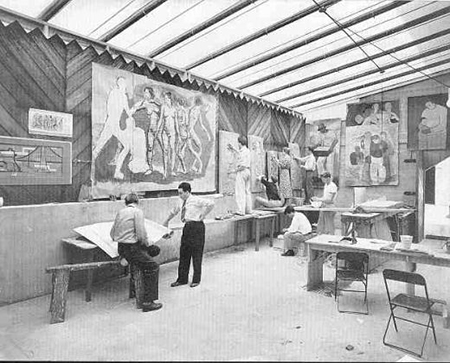
If you weren’t worried about the cliché, you’d call it the end of an era. Flashback to the early 1970s, dateline Los Angeles. The California taxpayer revolt is gaining momentum; it will soon lead to the free-market, trickle-down economic policies of Ronald Reagan and ... well, you know the rest. Public funding for arts institutions of all kinds is beginning to dry up, pitiful as a California drought — except that, for the arts, the spigots have never been turned back on. Wealthy — sometimes woefully healthy! — and mostly corporate egos have stepped in to fill the void, sometimes mistaking their own vision for the good of the cultural community.
So ... once upon a time there were these two, almost twin little art schools on the borders of MacArthur Park in downtown Los Angeles, Otis and Chouinard. Otis Art Institute had been going since 1918, the property left by Gen. Harrison Otis to Los Angeles County on condition the county use it as an art school. Who knew? The County itself was wealthy and healthy at the time, and gladly accepted the gift. Chouinard was founded in 1922 by the somewhat eccentric visionary Nelbert Chouinard, a woman dedicated to the teaching of art. If you look at period pictures of the two schools, you’ll know what they were about: easels and drawing boards, potters’ wheels and kilns. The images could have been made in late 19th century Europe. Both schools were committed to teaching “the basics,” the ABCs, the three Rs of art: painting, drawing, sculpture. Both were, in a sense, quixotic reminders of an aesthetic that was already under attack by the mid-1920s in Europe. Both struggled valiantly against the dual tides of dwindling financial support and post-WWII — well, post Vietnam — aesthetics.
Chouinard was the first to succumb to financial pressures. Walt Disney stepped in by 1955 to help out his old friend Nelbert and the school that had taught many of his studio artists. Along with his $10 million endowment, he brought his own vision, that of a comprehensive arts school that would embrace music, animation, dance and film; his first move in that direction was the 1961 merger with the Los Angeles Conservatory of Music. Walt died, of course, before his dream could be realized, but his brother Roy, the “Money Man,” was around for long enough to be influential in the 1972 closure of the Chouinard campus and its transformation into California Institute of the Arts; and the move, first to Burbank, then out to Valencia.
Otis followed suit. It first felt the heat of taxpayer fury in 1976, when the Los Angeles County Board of Supervisors bowed to the then imminent passage of Prop. 13 and voted to cut all county funds from the school. What were they doing in the art school business in the first place? Faced with the option of closure or merger, the Otis Board of Governors sought the latter. A David and Goliath battle ensued between local powerhouse USC, influential with the county supervisors, and little Parsons, a branch of the New School in distant New York. The choice for the school, so it was perceived, was between becoming the extended art department of a major university, or remaining a small, free-standing and independent spirited downtown art school. A full year’s battle ended, to everyone’s surprise, in approval of a merger with Parsons —one that, in hindsight, proved short-lived. But that’s another story.
That’s the history. But there’s more to it than that. Those mergers represented a sea change, a cultural shift, from public to private, often corporate funding for the arts. Art schools, since that moment, must make business sense. Fees, once little more than a token, skyrocketed. The schools, no longer the free-wheeling, informal operations they had been, for better or worse became institutionalized, a part of a regulated art school system with nationally agreed-upon standards and outcomes; you could say that from hotbeds of passionate and inspired amateurism, they have now become for the most part the seedbeds of professionalism in art.
It’s no surprise, I think, that these events took place coincident with the great change in aesthetics — from modernism, if you like, to post-modernism; from the values of traditional, “studio” art to the post-studio rejection of the limitations of any one medium and the embrace of the infinite possibilities of technological media. The vast field of vision opened up by the digital arts would have been unimaginable in old-school Otis or Chouinard. As Joni Mitchell once wrote, “something’s lost, but something’s gained.” And if I happen to sound a shade nostalgic in all this, recall that I was Dean at Otis in the bad old days of its transition. And while I am always excited by the new, there’s something in me that still clings to the time-tested values of the old. In an art school, for me, that’s the smell of paint.
